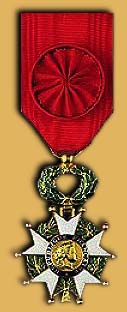Legion d’Honneur

The original "Fourragere" was first worn by prisoners of the Bastille, who were liberated in the French Revolution of 1789. After they were freed, the ex convicts, political prisoners of the oppressive French monarchy, fashioned the "decoration" from the prison hangman's rope! They then "paraded" around Paris with it as a distinctive "badge of honor!"
France's L'gion d'honneur was established by Napoleon Bonaparte when he was First Consul in 1802 to acknowledge outstanding military and civil service. It is currently France's premier order and is conferred for gallantry in action or for twenty years' distinguished military or civilian service in peace. The Order can be bestowed on foreigners. When given for war services it carries with it the automatic award of the Croix de Guerre with palm.
In the 90's the French government, modifying it's requirements, awarded the French Legion d'Honneur to all living WW1 vets who previously had been awarded the French Croix de Guerre, and who also had participated in five major battles of World War 1. Prior to that, to receive the Legion d'Honneur, it was required for a vet to have earned six awards of the Croix de Guerre with Palm. In WW1, a few US soldiers received the Legion d'Honneur immediately, bypassing the requirement to earn six Croix de Guerre palms, and when awarded the legion d'Honneur directly, received a Croix de Guerre with palm along with it automatically. A few years ago, the French government modified the requirements for WW1 soldiers again, granting the Legion d'Honneur to all surviving vets of WW1, whether they had received a Croix de Guerre in WW1 or not.
WW1 Citations for the Croix de Guerre
9th Infantry---French Croix de Guerre with two palms.
Palm awarded under Order No. 14.712 D, March 21, 1919, GHQ, French Armies of the East:
The Marshal of France, Commander in Chief of the French Armies of the East, cites in the Orders of the Army, the American 9th Infantry Regiment:
"This regiment took a glorious part in the operations engaged in by the 4th French Army in CHAMPAGNE, in October, 1918. On October 3rd, it participated in the attack on the strongly intrenched German positions between BLANC MONT and the MEDEAH FARM, and pushing forward as far as ST. ETIENNE-ARNES, made an advance of 6 kilometers. It took several thousand prisoners, captured cannon, machine guns, and important war materials. This attack, combined with that of the French divisions, resulted in the evacuation of both banks of the SUPPE and the Masif de NOTRE-DAME-DES-CHAMPS."
Additional palm awarded under Orderr No. 16.107 D, April 17, 1919, GHQ, French Armies of the East, with the following citation:
"During the offensive of July 18, 1918, (SOISSONS) , this regiment was unexpectedly thrown into action in the dead of night, over unknown and difficult terrain and displayed remarkable ardor and tenacity for two days despite fatigue and the difficulties of obtaining food and water, driving the enemy back 11 kilometers, capturing 2700 prisoners, 12 guns, and several hundred machine guns."
French Fourragere in the colors of the Croix de Guerre, under General Order No. 156 F, August 29, 1919, GHQ, French Armies of the East.
